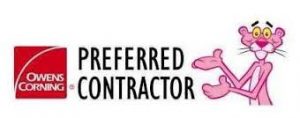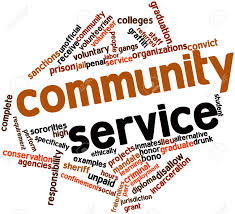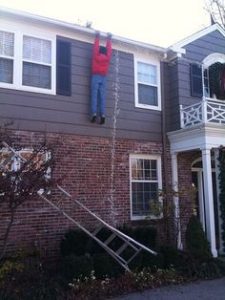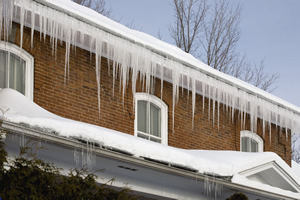So here it is springtime, ok almost summer. I had an old customer come to me the other day and ask “how should I go about a DIY roof cleaning from the black streaks that have formed on my roof over the years.” Additionally, he was curious of the manufactures warranty that the particular shingle carried against this particular issue.
Disclaimer: We at Lyons Roofing installed a 30-year Owens Corning Oakridge shingle on this home in 2003.
Standard warranty language: (Straight from the horses mouth)
What About Algae Resistance—If the shingles that you purchased were not specifically labeled as “Algae Resistant” (“AR”), then any discoloration caused due to algae is not covered by this warranty as explained in “What Is Not Covered” below. However, if you did purchase AR shingles, they are covered for the period described in the “Limited Warranty Information Table” at the end of this warranty following the date of installation (“AR Warranty Period”) against brown-black staining caused due to growth of blue-green algae (primarily the cyanobacteria Gloeocapsa magma). We do not cover the effects of other growth, such as mold, lichen and green algae. If brown-black staining occurs during the AR Warranty Period, you will be entitled to the following remedy:
- Remedy for Blue-Green Algae Growth—If your AR shingles are discolored due to blue-green algae growth during the first year of the AR Warranty Period, we will compensate you for the cost, including labor (such cost not to exceed the initial cost of the AR shingles plus the initial cost of installation), as reasonably determined by Owens Corning, to repair, replace or recover the affected AR shingles. For purposes of this AR shingle warranty, the term “repair” as used above refers to cleaning or otherwise removing any blue- green algae growth from affected AR shingles. Decisions regarding whether your AR shingles should be repaired, replaced or recovered will be made solely by Owens Corning.
- Proration—If your AR shingles have been installed longer than 1 year, labor will not be covered, and our compensation will be limited to a prorated amount of the original purchase price of the affected AR shingles. We will prorate your compensation to take into account the number of full years of use that you have enjoyed from the original installation date through the date of your claim. For example: If you make your claim anytime in the 4th year of the AR warranty and the AR Warranty Period is 10 years, our compensation to you will be in the amount of the original purchase price of the affected AR shingles, reduced by 3/10ths of the original purchase price of the affected AR shingles.
DIY Roof Cleaning
Now on to the fun stuff. How do you as a homeowner go about cleaning your own roof? First, please be safe and follow all safety procedures. Now the important thing to remember is confidence is everything, if you are uncomfortable, then it may be better to hire someone who climbs on roofs for a living, rather than risk your own hind parts.
The simplest way if your roof is more of a steeper pitch is to buy a special ladder that hooks over the ridge. Granted most roofers call it a “chicken ladder”, but hey make fun of me, I am going to be safe!
So now, on to the fun stuff, roof cleaning. Chemicals are your best friend (you don’t hear that often) in this case, do your research and find which product would be best suited for your application. Here are three options for your cleaning project.
- The eco-friendly, non-bleach, roof-cleaning method
Roof contractors and homeowners that use this method use high-grade eco-friendly products (you can buy these yourself at most home improvement stores) they do not contain toxic chemicals such as chlorine-bleach, phosphates or other chemicals that can kill vegetation and pollute waterways. This method also uses a low-pressure rinsing system, avoiding the use of damaging high pressure scrubbing or brushing.
- The chlorine-bleach roof cleaning method
Roofing contractors and homeowners who use sodium hypochlorite (chlorine bleach) mix it in high concentrations with other chemicals such as trisodium phosphate, also known as TSP.
They spray it on the roof and wait for it to dry and then re-apply it several times as needed. Stains and moss or lichens that do not come off on the day of treatment may eventually come off with rain in the months to come.
Most manufacturers will tell you the easiest mix is 1 part bleach, four parts water. Spray, rinse, and that should take care of your problem.
- The high-pressure power washing method
Some roofing contractors and homeowners have made the mistake of using use high pressure power washing methods to attempt to remove roof stains.
Plain and simple: DON’T DO IT!!!
This method can be extremely risky, you will more than likely damage your shingles. Remember you want to clean your roof, not replace it!
How to actually clean your roof!
- Check the weather forecast and choose a cool or overcast day with little to no wind so the spray hits your shingles, not the neighbors’. Those conditions allow the cleaning solution to soak deep into the algae colonies without evaporating too quickly.
- Clear debris, moss and algae from your roof as dry leaves, twigs and debris soak up water (ideal for algae growth) and can damage your Shingles. Your roof is supposed to be dry, and any collection of water because of settlement of debris would only cause problems to the roof.
- check your gutters and pipes for debris and blockage. Also trim or cut overhanging tree branches to minimize debris collection on the roof.
- Mix your solution in a small pump sprayer (1 part bleach, 4 parts hot water) if you are making yourself, of course test a discrete area first to ensure there is no discoloring. If you are using a store bought solution, follow all of the manufacturers directions (make sure the solution matches the type of roofing system you have).
- Saturate a large area of shingles with the cleaner. Start at the bottom row and work up to the peak. Spray until you see runoff. Re-spray any areas that dry out.
- Now comes the fun part. Blast it off! There are tools out there that make it a little easier but if you have the time and the patience a hose with a direct nozzle will do the trick, granted it is a slow process regardless of the tools you use. Take your time and make sure you get rid of all of those little critters growing on your roof.
Conclusion
If you get intimidated by this whole process, don’t worry you aren’t alone. There are plenty contractors out there that are willing to help. If you are in the local Louisville, KY area, give The Lyons Roofing CO. a call and we will be more than happy to walk you through it or come by and set up a maintenance and cleaning plan for your roof.





 A house is typically a family’s biggest investment. Routine maintenance on a house is essential for maximum usefulness and longevity. Being prepared for a harsh Kentucky winter is the key to avoiding costly repairs that can add up unexpectedly. One of the main parts of a house that needs to be inspected is the roof.
A house is typically a family’s biggest investment. Routine maintenance on a house is essential for maximum usefulness and longevity. Being prepared for a harsh Kentucky winter is the key to avoiding costly repairs that can add up unexpectedly. One of the main parts of a house that needs to be inspected is the roof.